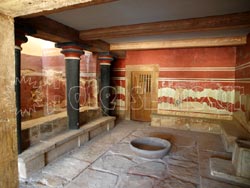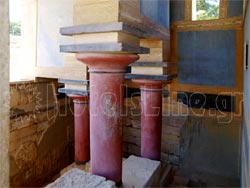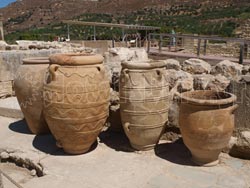The palace of Knossos is the largest of all the palaces in Crete. It is surrounded by an extensive city. The Palace was built on the low Kephala hill at the confluence of two streams. The choice of location and the subsequent growth of the settlement are connected with its proximity to the sea and the fertile earth of the region.
The site was first settled in the Neolithic period (6700-3200 B.C.). As early as this, there was an extensive settlement.
The first Palace was built around 1900 B.C. (Old Palace Period). From the few parts that are preserved, it appears that the basic plan was formed at that time. It was destroyed around 1700B.C. and the New Palace was built in its Place (New Palace Period). With the exception of some later additions, Arthur Evans uncovered and restored its ruins.
The palace is comprised of different buildings that grew up around the Central Court. There were entrances at all the main points, the most formal being the southwest and north. The West Wing includes shrines, official halls and extensive storage areas, and the East Wing, the "Royal Apartments" and workshops. There were storerooms and other areas to the north and south.
The palace displays a great variety of architectural features: storeys with flat roofs on different levels, indented or protruding facades, embellishments of stone horns and of alternating colors etc. A great variety of materials was used: slabs of green schist for floors, wooden columns, gypsum slabs on walls, floors and elsewhere. Polychrome plaster and wall paintings contributed to room decoration.
The Palace appears to have been the center of political, economic and religious authority. The main excavator, Arthur Evans, attempted to interpret the function of the spaces in the Palace and gave them names that reflected their use according to his opinion. This was based on the finds, mythological tradition, and analogies with ancient civilizations and his own era. These names are still current (e.g. 'Queen's Megaron' [hall], 'Piano Nobile' [upper floor], 'Throne Room') even though continuing research has put forward different views as to the function of same areas.
The Palace of Knossos continued in use after 1450 B.C. when the rest of the Cretan palaces were destroyed.
Most experts believe that new inhabitants from the Mycenaean Greek Mainland were installed in the Palace, due to the discovery of a Mycenaean archive of Linear B script. When the Palace ceased to function remains uncertain. At any rate, after 1380 B.C., a large part of its former glory had been lost.
|



|